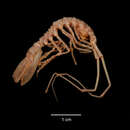en
names in breadcrumbs


“Dolichiscus profundus sp. nov.
Diagnosis. Eyes small. Lateral spines on peraeonal segment I short. Three spines on inner margin of carpus of peraeopod VI of the male.
Description. Eyes small and lateral. Body smooth; appendages long; pleon about two-fifths body length. Cephalon and peraeonal segment I fused; segment I with very short lateral extensions. Pleonal segment 1 indicated; segment 2 partially indicated; short lateral spines on indicated segment 3; posterior border convex. Coxae with tiny spines. Antenna 1 with flagellum about 2 times length of three peduncular segments combined; about 56 groups of aesthetascs along entire length of flagellum. Antenna 2 longer than body; flagellum with long articles (broken). Maxilliped with palp much longer than endite; exopod subtriangular. Peraeopod I short, gnathal with outer edge of dactylus rounded; distal part produced supporting small unguis. Peraeopod with needlelike unguis on dactylus; unguis longer than dactylus proper; inner margin of dactylus minutely scaled. Peraeopods III and IV like II, but longer. Carpus of peraeopod VI with three spines on convex inner margin. Penis elongate. Valves minutely tuberculated.
Measurements. Holotype male 37 mm long.
Type locality. About 275 km east of Cape Hallett; Eltanin 32-2113; 73°19'S, 174°53'W; 73°19'S, 174°52'W; February 9, 1968; 2897-2907 m.
Derivation of name. The name 'profundus,' from Latin for deep, refers to the depth of the type locality, which is greater than for D. meridionalis, the more common species.
Distribution. Known only from type locality.
Affinities. The species is most like D. meridionalis, but it has smaller eyes and three instead of six spines on the inner margin of the carpus of peraeopod VI. The lateral spines on peraeonal segment I are small, not greatly developed as they are on D. meridionalis or on D. pfefferi. The pleon is proportionately thicker, especially where it attaches to the peraeon. Also pleonal segment 1 is much shorter in D. profundus.
Remarks. Assuming that the other species of the genus have eyes of normal size, the eyes in this species are small, perhaps reflecting the great depth (about 2900 m) at which it was collected. It seems to be a species that evolved in the deeper habitat from D. meridionalis (greatest depth about 2000 m).”
(Schultz, George, 1981: 75)